Note
This is one of 199 standalone projects, maintained as part of the @thi.ng/umbrella monorepo and anti-framework.
🚀 Please help me to work full-time on these projects by sponsoring me on GitHub. Thank you! ❤️
- About
- Status
- Support packages
- Related packages
- Installation
- Dependencies
- Usage examples
- Basic usage patterns
- Interpolation & SVG generation
- Fuzzy search
- Histogram generation & result grouping
- Pagination
- Multiplexing / parallel transducer application
- Moving average using sliding window
- Benchmark function execution time
- Apply inspectors to debug transducer pipeline
- Stream parsing / structuring
- CSV parsing
- Early termination
- Scan operator
- Weighted random choices
- Keyframe interpolation
- API
- Authors
- License
Collection of ~170 lightweight, composable transducers, reducers, generators, iterators for functional data transformations.
This library provides altogether ~170 transducers, reducers, sequence generators (ES6 generators/iterators) and additional supporting functions for composing data transformation pipelines.
The overall concept and many of the core functions offered here are directly inspired by the original Clojure implementation by Rich Hickey, though the implementation does heavily differ (also in contrast to some other JS based implementations) and dozens of less common, but generally highly useful operators have been added. See full list below.
Furthermore, most transducers & reducers provided here accept an optional input
iterable, which allows them to be used directly as transformers instead of
having to wrap them in one of the execution functions (i.e.
transduce()/transduceRight(), reduce()/reduceRight(), iterator(),
run(), step()). If called this way, transducer functions will return a
transforming ES6 iterator (generator) and reducing functions will return a
reduced result of the given input iterable.
STABLE - used in production
Search or submit any issues for this package
This release corrects a longstanding stylistic issue regarding the order of
generic type args given to Reducer<A, B>, which now uses the
swapped & more logical order (i.e. reduce from A to B) and is the same order
of generic type args for Transducer and AsyncTransducer / AsyncReducer (in
the thi.ng/transducers-async
package).
Most userland code should be unimpacted by this change - this is only a breaking
change for custom reducer impls.
- @thi.ng/transducers-async - Async versions of various highly composable transducers, reducers and iterators
- @thi.ng/transducers-binary - Binary data related transducers & reducers
- @thi.ng/transducers-fsm - Transducer-based Finite State Machine transformer
- @thi.ng/transducers-hdom - Transducer based UI updater for @thi.ng/hdom
- @thi.ng/transducers-patch - Reducers for patch-based, immutable-by-default array & object editing
- @thi.ng/transducers-stats - Transducers for statistical / technical analysis
- @thi.ng/csv - Customizable, transducer-based CSV parser/object mapper and transformer
- @thi.ng/grid-iterators - 2D grid and shape iterators w/ multiple orderings
- @thi.ng/rstream - Reactive streams & subscription primitives for constructing dataflow graphs / pipelines
- @thi.ng/rstream-graph - Declarative dataflow graph construction for @thi.ng/rstream
- @thi.ng/rstream-log - Structured, multilevel & hierarchical loggers based on @thi.ng/rstream
- @thi.ng/sax - Transducer-based, SAX-like, non-validating, speedy & tiny XML parser
- HOFs, Transducers, Reducers
- Convolution, 1D/2D Cellular automata
- Disjoint Sets, Graph analysis, Signed Distance Fields
yarn add @thi.ng/transducersESM import:
import * as tx from "@thi.ng/transducers";Browser ESM import:
<script type="module" src="https://esm.run/@thi.ng/transducers"></script>For Node.js REPL:
const tx = await import("@thi.ng/transducers");Package sizes (brotli'd, pre-treeshake): ESM: 9.05 KB
- @thi.ng/api
- @thi.ng/arrays
- @thi.ng/checks
- @thi.ng/compare
- @thi.ng/compose
- @thi.ng/errors
- @thi.ng/math
- @thi.ng/random
Note: @thi.ng/api is in most cases a type-only import (not used at runtime)
73 projects in this repo's /examples directory are using this package:
| Screenshot | Description | Live demo | Source |
|---|---|---|---|
 |
Interactive image processing (adaptive threshold) | Demo | Source |
 |
ASCII art raymarching with thi.ng/shader-ast & thi.ng/text-canvas | Demo | Source |
 |
Large ASCII font text generator using @thi.ng/rdom | Demo | Source |
 |
Figlet-style bitmap font creation with transducers | Demo | Source |
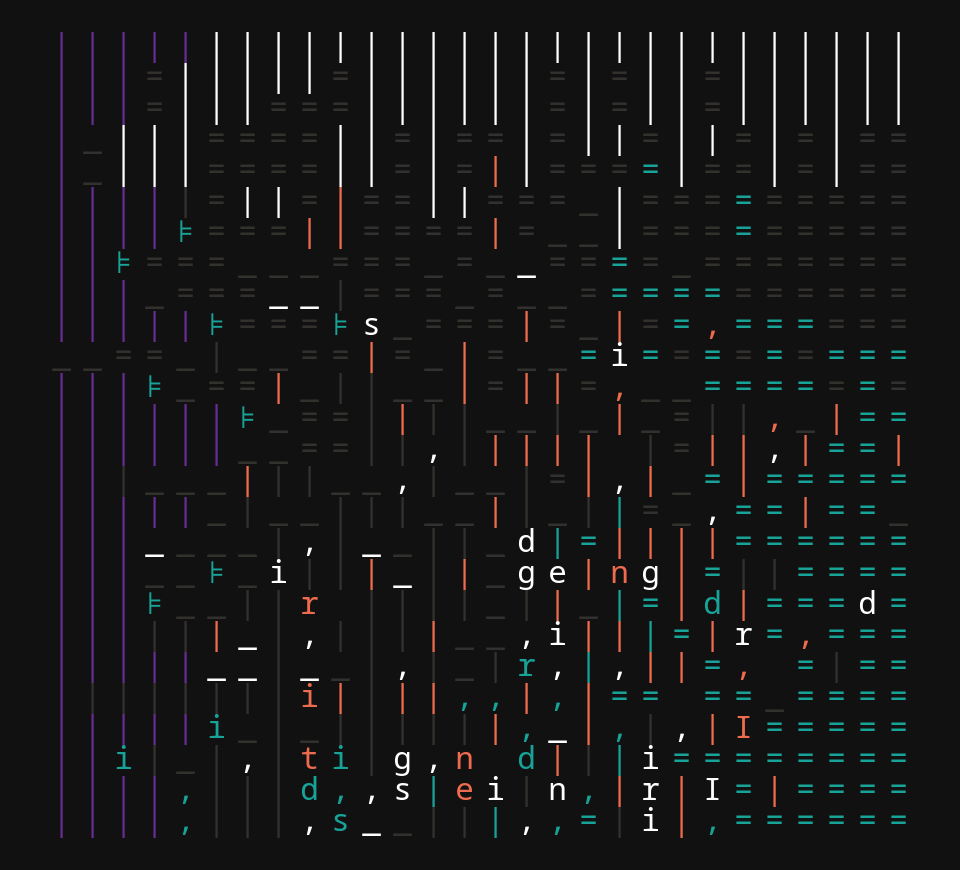 |
Self-modifying, animated typographic grid with emergent complex patterns | Demo | Source |
 |
2D transducer based cellular automata | Demo | Source |
 |
Tool to interactively compute & visualize color contrasts against WCAG threshold | Demo | Source |
 |
Heatmap visualization of this mono-repo's commits | Source | |
 |
Filterable commit log UI w/ minimal server to provide commit history | Demo | Source |
 |
Basic crypto-currency candle chart with multiple moving averages plots | Demo | Source |
 |
Color palette generation via dominant color extraction from uploaded images | Demo | Source |
 |
Interactive visualization of closest points on ellipses | Demo | Source |
 |
Interactive inverse FFT toy synth | Demo | Source |
 |
Fiber-based cooperative multitasking basics | Demo | Source |
 |
Shape conversions & operations using polygons with holes | Demo | Source |
 |
Piechart visualization of CSV data | Demo | Source |
 |
Hex grid generation & tessellations | Demo | Source |
| GPU-based data reduction using thi.ng/shader-ast & WebGL multi-pass pipeline | Demo | Source | |
 |
Visualization of different grid iterator strategies | Demo | Source |
 |
hdom update performance benchmark w/ config options | Demo | Source |
 |
Realtime analog clock demo | Demo | Source |
 |
Interactive pattern drawing demo using transducers | Demo | Source |
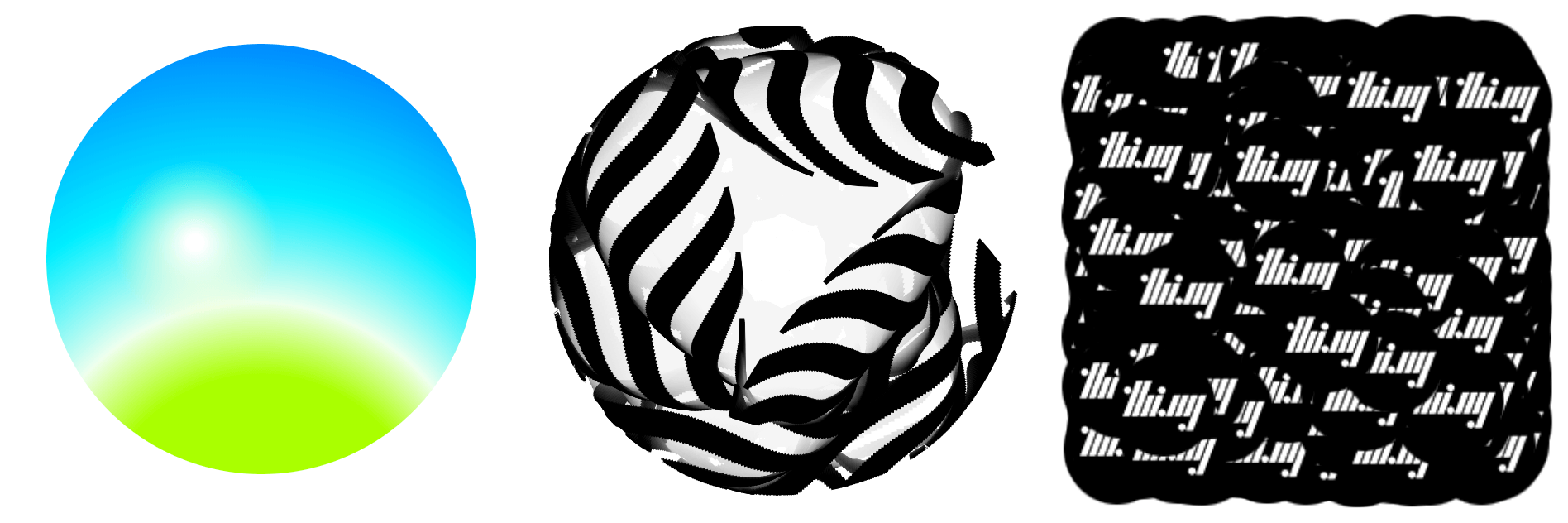 |
Various hdom-canvas shape drawing examples & SVG conversion / export | Demo | Source |
| Custom dropdown UI component w/ fuzzy search | Demo | Source | |
| Isolated, component-local DOM updates | Demo | Source | |
 |
Basic hiccup-based canvas drawing | Demo | Source |
 |
Canvas based Immediate Mode GUI components | Demo | Source |
 |
Animated sine plasma effect visualized using contour lines | Demo | Source |
 |
Transforming JSON into UI components | Demo | Source |
 |
Randomized space-filling, nested grid layout generator | Demo | Source |
 |
Browser REPL for a Lispy S-expression based mini language | Demo | Source |
 |
Worker based, interactive Mandelbrot visualization | Demo | Source |
 |
Mastodon API feed reader with support for different media types, fullscreen media modal, HTML rewriting | Demo | Source |
 |
CLI util to visualize umbrella pkg stats | Source | |
 |
Parser grammar livecoding editor/playground & codegen | Demo | Source |
| RGB waveform image analysis | Demo | Source | |
 |
Polygon to cubic curve conversion & visualization | Demo | Source |
 |
Animated, iterative polygon subdivisions & visualization | Demo | Source |
 |
Procedural stochastic text generation via custom DSL, parse grammar & AST transformation | Demo | Source |
 |
Unison wavetable synth with waveform editor | Demo | Source |
| Demonstates various rdom usage patterns | Demo | Source | |
 |
Minimal rdom-canvas animation | Demo | Source |
 |
rstream & transducer-based FSM for converting key event sequences into high-level commands | Demo | Source |
 |
rdom & hiccup-canvas interop test | Demo | Source |
| Full umbrella repo doc string search w/ paginated results | Demo | Source | |
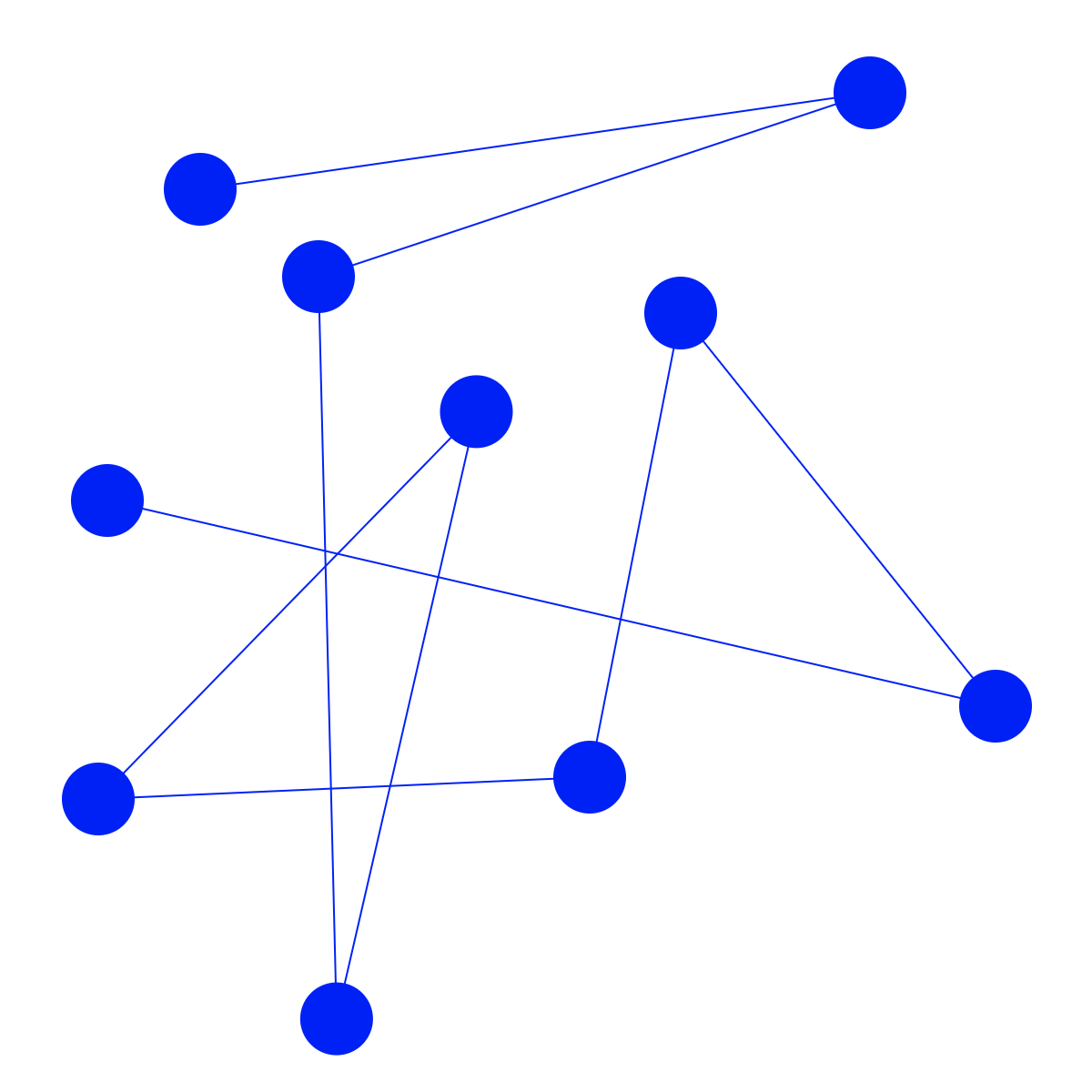 |
rdom powered SVG graph with draggable nodes | Demo | Source |
 |
Defining & using basic Web Components (with shadow DOM) via @thi.ng/rdom & @thi.ng/meta-css | Demo | Source |
 |
Responsive image gallery with tag-based Jaccard similarity ranking | Demo | Source |
 |
Generative audio synth offline renderer and WAV file export | Demo | Source |
 |
Animated Voronoi diagram, cubic splines & SVG download | Demo | Source |
| Minimal rstream dataflow graph | Demo | Source | |
 |
Minimal demo of using rstream constructs to form an interceptor-style event loop | Demo | Source |
 |
Interactive grid generator, SVG generation & export, undo/redo support | Demo | Source |
| rstream based UI updates & state handling | Demo | Source | |
 |
Minimal rstream sync() example using rdom | Demo | Source |
 |
2D scenegraph & shape picking | Demo | Source |
 |
Shader-AST meta-programming techniques for animated function plots | Demo | Source |
 |
Fork-join worker-based raymarch renderer (JS/CPU only) | Demo | Source |
 |
Simplistic SVG bar chart component | Demo | Source |
 |
SVG path parsing & dynamic resampling | Demo | Source |
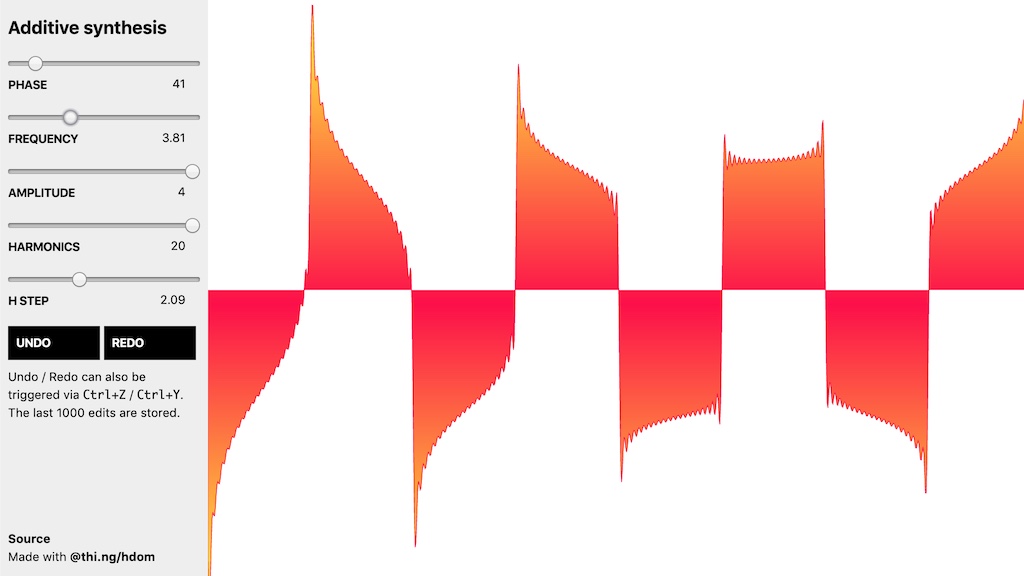 |
Additive waveform synthesis & SVG visualization with undo/redo | Demo | Source |
 |
hdom based slide deck viewer & slides from my ClojureX 2018 keynote | Demo | Source |
 |
Tree-based UI to find & explore thi.ng projects via their associated keywords | Demo | Source |
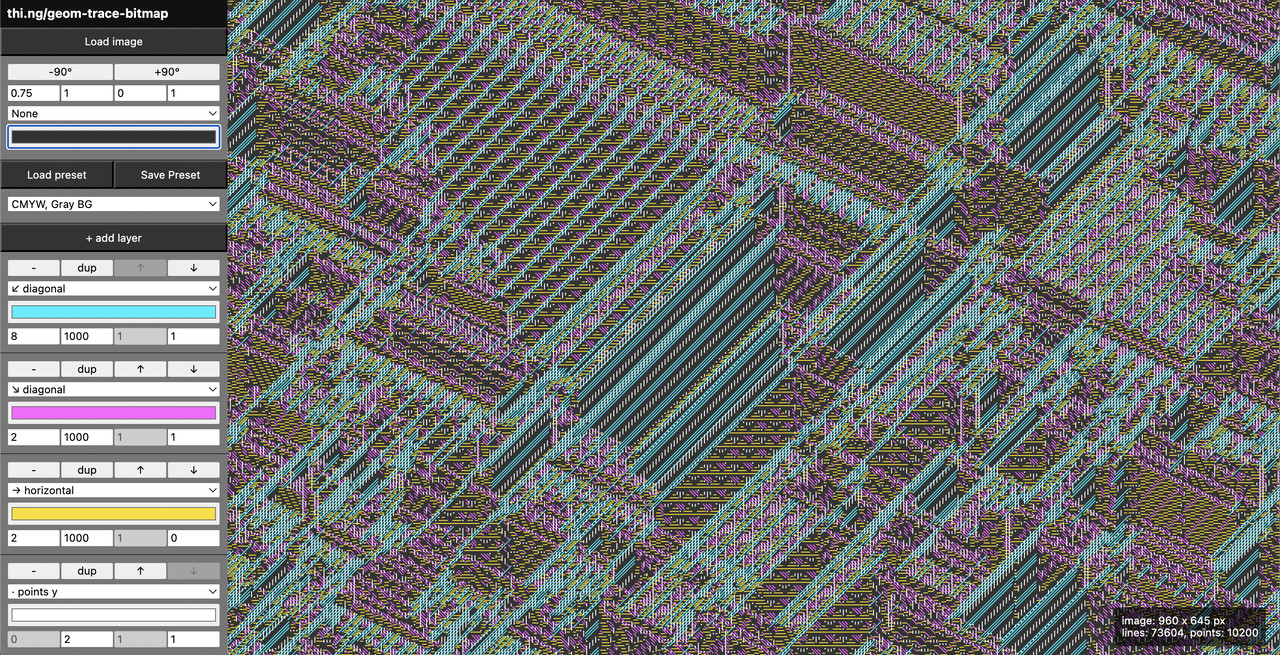 |
Multi-layer vectorization & dithering of bitmap images | Demo | Source |
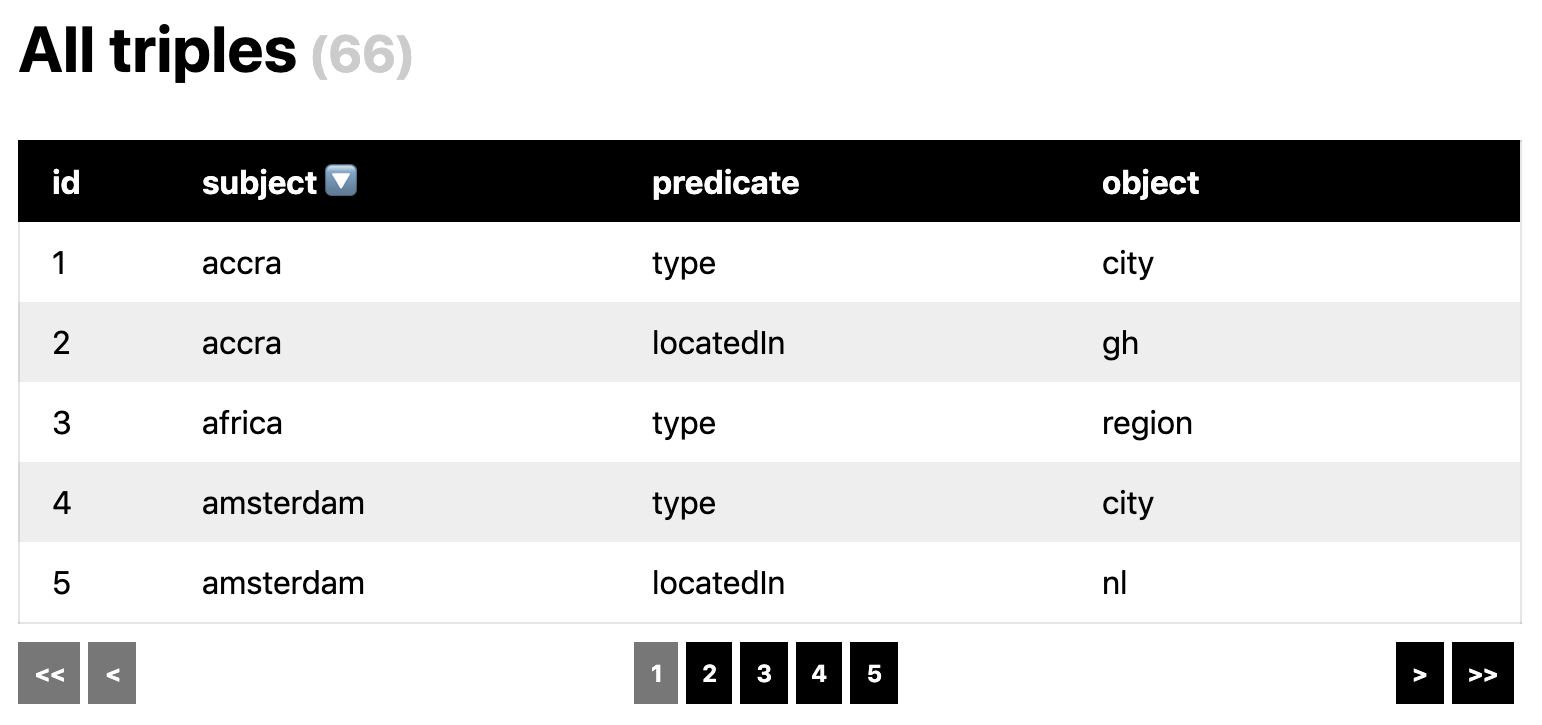 |
Triple store query results & sortable table | Demo | Source |
 |
Interactive ridge-line plot | Demo | Source |
 |
rdom & WebGL-based image channel editor | Demo | Source |
 |
WebGL multi-colored cube mesh | Demo | Source |
 |
Drawing to floating point offscreen / multi-pass shader pipeline | Demo | Source |
 |
WebGL instancing, animated grid | Demo | Source |
 |
WebGL MSDF text rendering & particle system | Demo | Source |
 |
1D Wolfram automata with OBJ point cloud export | Demo | Source |
 |
XML/HTML/SVG to hiccup/JS conversion | Demo | Source |
import { comp, distinct, filter, map } from "@thi.ng/transducers";
// compose transducer
xform = comp(
filter((x) => (x & 1) > 0), // odd numbers only
distinct(), // distinct numbers only
map((x) => x * 3) // times 3
);
import { transduce, push } from "@thi.ng/transducers";
// collect into array (push)
transduce(xform, push(), [1, 2, 3, 4, 5, 4, 3, 2, 1]);
// [ 3, 9, 15 ]
// re-use same xform, but collect into ES6 Set
transduce(xform, conj(), [1, 2, 3, 4, 5, 4, 3, 2, 1]);
// Set { 3, 9, 15 }
import { iterator } from "@thi.ng/transducers";
// or apply as transforming iterator
// no reduction, only transformations
[...iterator(xform, [1, 2, 3, 4, 5])]
// [ 3, 9, 15]
// alternatively provide an input iterable and
// use xform as transforming iterator
[...filter((x) => /[A-Z]/.test(x), "Hello World!")]
// ["H", "W"]
import { step } from "@thi.ng/transducers";
// single step execution
// returns undefined if transducer returned no result for this input
// returns array if transducer step produced multiple results
f = step(xform);
f(1) // 3
f(2) // undefined
f(3) // 9
f(4) // undefined
f = step(take)This example uses the @thi.ng/geom package for quick SVG generation.
import { asSvg, svgDoc, circle, polyline } from "@thi.ng/geom";
// source values
const values = [5, 10, 4, 8, 20, 2, 11, 7];
// interpolate values and transform into 2D points
const vertices = [...iterator(
comp(
interpolateHermite(10),
mapIndexed((x, y) => [x, y])
),
// duplicate first & last vals (1x LHS / 2x RHS)
// this is only needed for hermite interpolation
// (see doc string for `interpolateHermite`)
extendSides(values, 1, 2)
)];
// generate SVG
asSvg(
svgDoc(
{ width: 800, height: 200, "stroke-width": 0.1 },
// interpolated points as polyline
polyline(vertices, { stroke: "red" }),
// original values as dots
...values.map((y, x) => circle([x * 10, y], 0.2))
)
)import { filterFuzzy } from "@thi.ng/transducers";
[...filterFuzzy("ho", ["hello", "hallo", "hey", "heyoka"])]
// ["hello", "hallo", "heyoka"]
[...filterFuzzy("hlo", ["hello", "hallo", "hey", "heyoka"])]
// ["hello", "hallo"]
// works with any array-like values & supports custom key extractors
[...filterFuzzy(
[1, 3],
{ key: (x) => x.tags },
[
{ tags: [1, 2, 3] },
{ tags: [2, 3, 4] },
{ tags: [4, 5, 6] },
{ tags: [1, 3, 6] }
]
)]
// [ { tags: [ 1, 2, 3 ] }, { tags: [ 1, 3, 6 ] } ]import { frequencies, map, reduce, transduce } from "@thi.ng/transducers";
// use the `frequencies` reducer to create
// a map counting occurrence of each value
transduce(map((x) => x.toUpperCase()), frequencies(), "hello world");
// Map { 'H' => 1, 'E' => 1, 'L' => 3, 'O' => 2, ' ' => 1, 'W' => 1, 'R' => 1, 'D' => 1 }
// reduction only (no transform)
reduce(frequencies(), [1, 1, 1, 2, 3, 4, 4]);
// Map { 1 => 3, 2 => 1, 3 => 1, 4 => 2 }
// direct reduction if input is given
frequencies([1, 1, 1, 2, 3, 4, 4]);
// Map { 1 => 3, 2 => 1, 3 => 1, 4 => 2 }
// with optional key function, here to bin by word length
frequencies(
(x) => x.length,
"my camel is collapsing and needs some water".split(" ")
);
// Map { 2 => 2, 5 => 3, 10 => 1, 3 => 1, 4 => 1 }import { groupByMap } from "@thi.ng/transducers";
// actual grouping (here: by word length)
groupByMap(
{ key: (x) => x.length },
"my camel is collapsing and needs some water".split(" ")
);
// Map {
// 2 => [ 'my', 'is' ],
// 3 => [ 'and' ],
// 4 => [ 'some' ],
// 5 => [ 'camel', 'needs', 'water' ],
// 10 => [ 'collapsing' ]
// }import { page, comp, iterator, map, padLast, range } from "@thi.ng/transducers";
// extract only items for given page id & page length
[...page(0, 5, range(12))]
// [ 0, 1, 2, 3, 4 ]
// when composing with other transducers
// it's most efficient to place `page()` early on in the chain
// that way only the page items will be further processed
[...iterator(comp(page(1, 5), map(x => x * 10)), range(12))]
// [ 50, 60, 70, 80, 90 ]
// use `padLast()` to fill up missing values
[...iterator(comp(page(2, 5), padLast(5, "n/a")), range(12))]
// [ 10, 11, 'n/a', 'n/a', 'n/a' ]
// no values produced for invalid pages
[...page(3, 5, range(12))]
// []multiplex and multiplexObj can be used to transform values in
parallel using the provided transducers (which can be composed as usual)
and results in a tuple or keyed object.
import { map, multiplex, multiplexObj, push, transduce } from "@thi.ng/transducers";
transduce(
multiplex(
map((x) => x.charAt(0)),
map((x) => x.toUpperCase()),
map((x) => x.length)
),
push(),
["Alice", "Bob", "Charlie"]
);
// [ [ "A", "ALICE", 5 ], [ "B", "BOB", 3 ], [ "C", "CHARLIE", 7 ] ]
transduce(
multiplexObj({
initial: map((x) => x.charAt(0)),
name: map((x) => x.toUpperCase()),
len: map((x) => x.length)
}),
push(),
["Alice", "Bob", "Charlie"]
);
// [ { len: 5, name: 'ALICE', initial: 'A' },
// { len: 3, name: 'BOB', initial: 'B' },
// { len: 7, name: 'CHARLIE', initial: 'C' } ]import { comp, map, mean, partition, push, reduce transduce } from "@thi.ng/transducers";
// use nested reduce to compute window averages
transduce(
comp(
partition(5, 1),
map(x => reduce(mean(), x))
),
push(),
[1, 2, 3, 3, 4, 5, 5, 6, 7, 8, 8, 9, 10]
)
// [ 2.6, 3.4, 4, 4.6, 5.4, 6.2, 6.8, 7.6, 8.4 ]This combined transducer is also directly available as:
import { movingAverage } from "@thi.ng/transducers";
[...movingAverage(5, [1, 2, 3, 3, 4, 5, 5, 6, 7, 8, 8, 9, 10])]
// [ 2.6, 3.4, 4, 4.6, 5.4, 6.2, 6.8, 7.6, 8.4 ]import { benchmark, mean, repeatedly, transduce } from "@thi.ng/transducers";
// function to test
fn = () => {
let x;
for (i = 0; i < 1e6; i++) {
x = Math.cos(i);
}
return x;
};
// compute the mean of 100 runs
transduce(benchmark(), mean(), repeatedly(fn, 100));
// 1.93 (milliseconds)import { comp, filter, map, push, trace, transduce } from "@thi.ng/transducers";
// alternatively, use sideEffect() for arbitrary side fx
transduce(
comp(
trace("orig"),
map((x) => x + 1),
trace("mapped"),
filter((x) => (x & 1) > 0)
),
push(),
[1, 2, 3, 4]
);
// orig 1
// mapped 2
// orig 2
// mapped 3
// orig 3
// mapped 4
// orig 4
// mapped 5
// [ 3, 5 ]The struct transducer is simply a composition of: partitionOf -> partition -> rename -> mapKeys. See code
here.
import { struct } from "@thi.ng/transducers";
// Higher-order transducer to convert linear input into structured objects
// using given field specs and ordering. A single field spec is an array of
// 2 or 3 items: `[name, size, transform?]`. If `transform` is given, it will
// be used to produce the final value for this field. In the example below,
// it is used to unwrap the ID field values, e.g. from `[0] => 0`
[
...struct(
[["id", 1, (id) => id[0]], ["pos", 2], ["vel", 2], ["color", 4]],
[0, 100, 200, -1, 0, 1, 0.5, 0, 1, 1, 0, 0, 5, 4, 0, 0, 1, 1]
)
];
// [ { color: [ 1, 0.5, 0, 1 ],
// vel: [ -1, 0 ],
// pos: [ 100, 200 ],
// id: 0 },
// { color: [ 0, 0, 1, 1 ],
// vel: [ 5, 4 ],
// pos: [ 0, 0 ],
// id: 1 } ]import { comp, map, mapcat, push, rename, transduce } from "@thi.ng/transducers";
transduce(
comp(
// split into rows
mapcat((x) => x.split("\n")),
// split each row
map((x) => x.split(",")),
// convert each row into object, rename array indices
rename({ id: 0, name: 1, alias: 2, num: "length" })
),
push(),
["100,typescript\n101,clojure,clj\n110,rust,rs"]
);
// [ { num: 2, name: 'typescript', id: '100' },
// { num: 3, alias: 'clj', name: 'clojure', id: '101' },
// { num: 3, alias: 'rs', name: 'rust', id: '110' } ]import { comp, flatten, push, take, transduce } from "@thi.ng/transducers";
// result is realized after max. 7 values, irrespective of nesting
transduce(comp(flatten(), take(7)), push(), [
1,
[2, [3, 4, [5, 6, [7, 8], 9, [10]]]]
]);
// [1, 2, 3, 4, 5, 6, 7]import {
comp, count, iterator, map, push, pushCopy, repeat, scan, transduce
} from "@thi.ng/transducers";
// this transducer uses 2 scans (a scan = inner reducer per item)
// 1) counts incoming values
// 2) forms an array of the current counter value `x` & repeated `x` times
// 3) emits results as series of reductions in the outer array produced
// by the main reducer
// IMPORTANT: since arrays are mutable we use `pushCopy` as the inner reducer
// instead of `push` (the outer reducer)
xform = comp(
scan(count()),
map(x => [...repeat(x,x)]),
scan(pushCopy())
)
[...iterator(xform, [1, 1, 1, 1])]
// [ [ [ 1 ] ],
// [ [ 1 ], [ 2, 2 ] ],
// [ [ 1 ], [ 2, 2 ], [ 3, 3, 3 ] ],
// [ [ 1 ], [ 2, 2 ], [ 3, 3, 3 ], [ 4, 4, 4, 4 ] ] ]
// more simple & similar to previous, but without the 2nd xform step
transduce(comp(scan(count()), scan(pushCopy())), push(), [1,1,1,1])
// [ [ 1 ], [ 1, 2 ], [ 1, 2, 3 ], [ 1, 2, 3, 4 ] ]import { choices, frequencies, take, transduce } from "@thi.ng/transducers";
[...take(10, choices("abcd", [1, 0.5, 0.25, 0.125]))]
// [ 'a', 'a', 'b', 'a', 'a', 'b', 'a', 'c', 'd', 'b' ]
transduce(
take(1000),
frequencies(),
choices("abcd", [1, 0.5, 0.25, 0.125])
);
// Map { 'c' => 132, 'a' => 545, 'b' => 251, 'd' => 72 }See
tween()
docs for details.
import { tween } from "@thi.ng/transducers";
[
...tween(
10,
0,
100,
(a, b) => [a, b],
([a, b], t) => Math.floor(a + (b - a) * t),
[20, 100],
[50, 200],
[80, 0]
)
];
// [ 100, 100, 100, 133, 166, 200, 133, 66, 0, 0, 0 ]Apart from type aliases, the only real types defined are:
Reducers are the core building blocks of transducers. Unlike other
implementations using OOP approaches, a Reducer in this lib is a simple
3-element array of functions, each addressing a separate processing step.
The bundled reducers are all wrapped in functions to provide a uniform API (and some of them can be preconfigured and/or are stateful closures). However, it's completely fine to define stateless reducers as constant arrays.
A Reducer is a 3-tuple of functions defining the different stages of a
reduction process: A Reducer<A, B> reduces values of type A to a single value
of type B.
The tuple items/functions in order:
- Initialization function used to produce an initial default result (only used if no such initial result was given by the user)
- Completion function to post-process an already reduced result (for most reducers this is merely the identity function)
- Accumulation function, merging a new input value with the currently existing (partially) reduced result/accumulator
type Reducer<A, B> = [
// init
() => B,
// completion
(x: B) => B,
// accumulation
(acc: B, x: A) => B
];
// A concrete example:
const push: Reducer<any, any[]> = [
// init
() => [],
// completion (nothing to do in this case)
(acc) => acc,
// accumulation
(acc, x) => (acc.push(x), acc)
];Simple type wrapper to mark & identify a reducer's early termination. Does not modify wrapped value by injecting magic properties.
import type { IDeref } from "@thi.ng/api";
class Reduced<T> implements IDeref<T> {
protected value: T;
constructor(val: T);
deref(): T;
}Instances can be created via reduced(x) and handled via these helper
functions:
reduced(x: any): anyisReduced(x: any): booleanensureReduced(x: any): Reduced<any>unreduced(x: any): any
By default reduce() consumes inputs via the standard ES6 Iterable interface,
i.e. using a for..of.. loop, but the function also supports optimized routes
for some types: Array-like inputs are consumed via a traditional for-loop and
custom optimized iterations can be provided via implementations of the
IReducible interface in the source collection type. Examples can be found
here:
Note: The IReducible interface is only used by reduce(), transduce()
and run().
From Rich Hickey's original definition:
A transducer is a transformation from one reducing function to another
As shown in the examples above, transducers can be dynamically composed (using
comp()) to form arbitrary data transformation pipelines without causing large
overheads for intermediate collections.
type Transducer<A, B> = (rfn: Reducer<B, any>) => Reducer<A, any>;
// concrete example of a stateless transducer (expanded for clarity)
function map<A, B>(fn: (x: A) => B): Transducer<A, B> {
return ([init, complete, reduce]: Reducer<B, any>) => {
return <Reducer<A, any>>[
init,
complete,
(acc, x: A) => reduce(acc, fn(x))
];
};
}
// stateful transducer
// removes successive value repetitions
function dedupe<T>(): Transducer<T, T> {
return ([init, complete, reduce]: Reducer<T, any>) => {
// state initialization
let prev = {};
return <Reducer<T, any>>[
init,
complete,
(acc, x) => {
if (prev !== x) acc = reduce(acc, x);
prev = x;
return acc;
}
];
};
}Interface for types able to provide some internal functionality (or derive some
related transformation) as Transducer. Implementations of this interface can
be directly passed to all functions in this package where a Transducer arg is
expected.
import { map, push, range, transduce, type IXform } from "@thi.ng/transducers";
class Mul implements IXform<number, number> {
constructor(public factor = 10) {}
xform() {
return map((x) => this.factor * x);
}
}
transduce(new Mul(11), push(), range(4))
// [0, 11, 22, 33, 44]
import { comp, drop, push, range, takeNth, transduce } from "@thi.ng/transducers";
// also usable w/ comp(), iterator(), step(), run() etc.
transduce(
comp(drop(1), new Mul(11), takeNth(2)),
push(),
range(4)
)
// [11, 33]comp(f1, f2, ...)
Returns new transducer composed from given transducers. Data flow is from left to right. Offers fast paths for up to 10 args. If more are given, composition is done dynamically via for loop.
compR(rfn: Reducer<any, any>, fn: (acc, x) => any): Reducer<any, any>
Helper function to compose reducers.
iterator<A, B>(tx: Transducer<A, B>, xs: Iterable<A>): IterableIterator<B>
Similar to transduce(), but emits results as ES6 iterator (and hence doesn't
use a reduction function).
reduce<A, B>(rfn: Reducer<A, B>, acc?: A, xs: Iterable<B>): A
Reduces xs using given reducer and optional initial accumulator/result. If
xs implements the IReducible interface, delegates to that implementation.
Likewise, uses a fast route if xs is an ArrayLike type.
reduceRight<A, B>(rfn: Reducer<A, B>, acc?: A, xs: ArrayLike<B>): A
Similar to reduce, however only accepts ArrayLike sources and reduces them
into right-to-left order.
transduce<A, B, C>(tx: Transducer<A, B>, rfn: Reducer<C, B>, acc?: C, xs: Iterable<A>): C
Transforms iterable using given transducer and combines results with given reducer and optional initial accumulator/result.
transduceRight<A, B, C>(tx: Transducer<A, B>, rfn: Reducer<C, B>, acc?: C, xs: ArrayLike<A>): C
Similar to transduce, however only accepts ArrayLike sources and processes
them into right-to-left order.
run<A, B>(tx: Transducer<A, B>, fx: (x: B) => void, xs: Iterable<A>)
Transforms iterable with given transducer and optional side effect without any
reduction step. If fx is given it will be called with every value produced by
the transducer. If fx is not given, the transducer is assumed to include at
least one sideEffect() step itself. Returns nothing.
consume(src: Iterable<any>): void
Similar to run(), consumes given iterable, presumably for any implicit
side-effects. Iterable MUST be finite!
import { consume, repeatedly2d } from "@thi.ng/transducers";
// here the function given to repeatedly2d() has only a side-effect, however
// repeatedly2d() itself is lazy. Using consume() then forces this lazy iterator/generator
// to be realized and so also the side-effects to be executed
consume(repeatedly2d((x, y) => console.log("output:", [x, y]), 2, 3));
// output: [ 0, 0 ]
// output: [ 1, 0 ]
// output: [ 0, 1 ]
// output: [ 1, 1 ]
// output: [ 0, 2 ]
// output: [ 1, 2 ]All of the following functions can be used and composed as transducers. With a few exceptions, most also accept an input iterable and then directly yield a transforming iterator, e.g.
import { map, push, range, transduce } from "@thi.ng/transducers";
// as transducer
transduce(map((x) => x*10), push(), range(4))
// [ 0, 10, 20, 30 ]
// as transforming iterator
[...map((x) => x*10, range(4))]
// [ 0, 10, 20, 30 ]- benchmark
- cat
- converge
- convolve2d
- dedupe
- delayed
- distinct
- dropNth
- dropWhile
- drop
- duplicate
- filterFuzzy
- filter
- flattenWith
- flatten
- flatten1
- indexed
- interleave
- interpolate
- interpolate-hermite
- interpolate-linear
- interpose
- keep
- labeled
- length
- mapDeep
- mapIndexed
- mapKeys
- mapNth
- mapVals
- map
- mapcat
- matchFirst
- matchLast
- movingAverage
- movingMedian
- multiplexObj
- multiplex
- noop
- padLast
- page
- partitionBy
- partitionOf
- partitionSort
- partitionSync
- partitionTime
- partitionWhen
- partition
- peek
- pluck
- rechunk
- rename
- sample
- scan
- selectKeys
- sideEffect
- slidingWindow
- streamShuffle
- streamSort
- struct
- syncTuples
- swizzle
- takeLast
- takeNth
- takeWhile
- take
- throttleTime
- throttle
- toggle
- trace
- wordWrap
- choices
- concat
- curve
- cycle
- dup
- extendSides
- iterate
- keyPermutations
- keys
- line
- normRange
- normRange2d
- normRange3d
- padSides
- pairs
- palindrome
- permutations
- permutationsN
- range
- range2d
- range3d
- rangeNd
- repeat
- repeatedly
- repeatedly2d
- repeatedly3d
- reverse
- sortedKeys
- symmetric
- tween
- vals
- wrapSides
- zip
As with transducer functions, reducer functions can also given an optional input
iterable. If done so, the function will consume the input and return a reduced
result (as if it would be called via reduce()).
- add
- assocMap
- assocObj
- conj
- count
- div
- every
- fill
- frequencies
- groupBinary
- groupByMap
- groupByObj
- last
- max
- maxCompare
- maxMag
- mean
- min
- minCompare
- minMag
- minMax
- mul
- normCount
- normFrequencies
- normFrequenciesAuto
- push
- pushCopy
- pushKeys
- pushSort
- reductions
- some
- sortedFrequencies
- str
- sub
- Karsten Schmidt (Main author)
- Gavin Cannizzaro
- @nkint
If this project contributes to an academic publication, please cite it as:
@misc{thing-transducers,
title = "@thi.ng/transducers",
author = "Karsten Schmidt and others",
note = "https://thi.ng/transducers",
year = 2016
}© 2016 - 2024 Karsten Schmidt // Apache License 2.0




